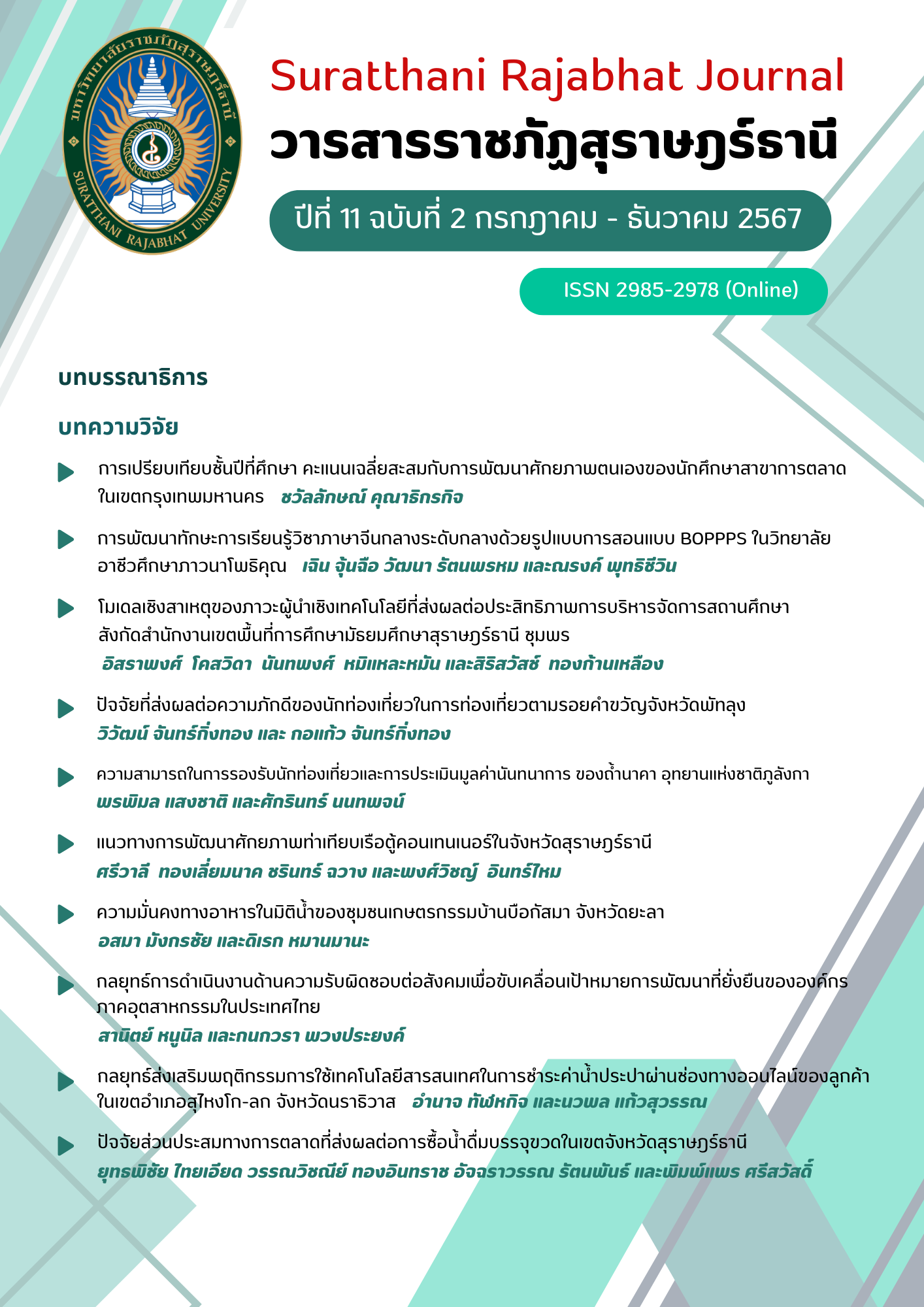กลยุทธ์ส่งเสริมพฤติกรรมการใช้เทคโนโลยีสารสนเทศในการชำระค่าน้ำประปาผ่านช่องทางออนไลน์ของลูกค้าในเขตอำเภอสุไหงโก-ลก จังหวัดนราธิวาส
Main Article Content
บทคัดย่อ
งานวิจัยนี้มีวัตถุประสงค์เพื่อ 1) วิเคราะห์ปัจจัยที่ส่งผลต่อพฤติกรรมการใช้เทคโนโลยีสารสนเทศ 2) วิเคราะห์สภาพปัจจัยภายในและปัจจัยภายนอกของการประปาส่วนภูมิภาค และ3) กำหนดกลยุทธ์ส่งเสริมพฤติกรรมการใช้เทคโนโลยีสารสนเทศในการชำระค่าน้ำประปาผ่านช่องทางออนไลน์ของลูกค้า ใช้รูปแบบการวิจัยแบบผสมผสานวิธี โดยใช้แบบสอบถาม ประเด็นการสัมภาษณ์และการสนทนากลุ่มกับกลุ่มตัวอย่างและกลุ่มเป้าหมายที่เป็นลูกค้า จำนวน 375 คน ผู้บริหาร หัวหน้างานและพนักงาน จำนวน 26 คน วิเคราะห์ข้อมูลเชิงคุณภาพด้วยการวิเคราะห์เนื้อหาและวิเคราะห์ข้อมูลเชิงปริมาณด้วยค่าสถิติร้อยละ ค่าเฉลี่ย ส่วนเบี่ยงเบนมาตรฐาน การแจกแจงความถี่และการวิเคราะห์ถดถอยพหุคูณ ผลการวิจัย พบว่า 1) พฤติกรรมการใช้เทคโนโลยีสารสนเทศในการชำระค่าน้ำประปาส่วนใหญ่อยู่ในขั้นตื่นตัวหรือรับทราบ โดยปัจจัยที่ส่งผลต่อการใช้เทคโนโลยีสารสนเทศในการชำระค่าน้ำประปา ประกอบด้วย 3 ปัจจัยและสามารถร่วมกันพยากรณ์ได้ร้อยละ 76.70 โดยสภาพปัจจัยภายในและปัจจัยภายนอกของการประปาส่วนภูมิภาค ควรมีการมุ่งเน้นไปที่การปรับปรุงประสิทธิภาพของด้านความปลอดภัยและด้านระบบการออกใบเสร็จรับเงินและลดความยุ่งยากซับซ้อน ทั้งนี้ กลยุทธ์ส่งเสริมพฤติกรรมการใช้เทคโนโลยีสารสนเทศในการชำระ ค่าน้ำประปาผ่านช่องทางออนไลน์ ประกอบด้วย กลยุทธ์พัฒนาระบบการชำระค่าน้ำประปาออนไลน์ กลยุทธ์ปรับปรุงระบบออกใบเสร็จรับเงิน กลยุทธ์ประชาสัมพันธ์เชิงรุกและกลยุทธ์ลดข้อจำกัดในการเข้าถึงการใช้บริการชำระค่าน้ำประปาออนไลน์ ผลจากการวิจัยจะนำไปสู่การสร้างแผนการปฏิบัติและเป็นแนวทางส่งเสริมและผลักดันการใช้เทคโนโลยีสารสนเทศในการเพิ่มประสิทธิภาพและเพิ่มมูลค่าให้แก่สินค้าและบริการขององค์กรต่อไป
Article Details

This work is licensed under a Creative Commons Attribution-NonCommercial-NoDerivatives 4.0 International License.
References
Aunruen, S. (2017). A Causal Relationship Model of Adoption and the Use of Technology that Affect Behaviours’ for the Shopping Applications on Smart Phones of the Population in Bangkok and its Vicinity [Unpublished master’s thesis]. Rangsit University.
Chaiwawattrakul, S. (2021). Readiness and satisfaction in using the mobile agricultural application prototype. Ubon Ratchathani University.
Chaweesuk, S. & Wongjatupat, S. (2012). Theory of acceptance of information technology use. KMITL Information Technology Journal, 1(1), 1-21. https://www.it.kmitl.ac.th/~journal/index.php/main_journal/article/download/2/4
Digital Thailand Development Plan. (2017). Digital Thailand. Office of the National Digital Economy and Society Commission.
Janthala, J., Pholphaengkwa, R., Dangsakul, K. & Sawang, K. (2023). Factors of Technology Acceptance Influencing Decision Making on DOPA Digital ID System Via Smartphone of User in Udonthani Province. Academic and research journals, Northeastern University, 13(2),46-60. https://so04.tci-thaijo.org/index.php/neuarj/article/view/263465/179539
Jarusen, J. (2021). Influence of financial transaction technology on the performance of small and medium enterprise operators. Dusit Thani College Journal, 15(2), 162-173. (in Thai).
Kaewsuwan, N. & Theppaya, T. (2023). Factors Influencing Information Technology Adoption of the Educational Opportunity Expansion Schools’ Teachers in Pattani Primary Educational Service Area in Pattani Province. Journal of Information and Learning, 34(1), 87-97. (in Thai). https://so04.tci-thaijo.org/index.php/jil/article/view/259021/178966
Khajannan, N. (2009). Strategic management. Se-ed SE-ED Publisher.
Khanabkaew, C. & Chaiprasit, K. (2019). Attitudes and risk perceptions that influence acceptance of E-Payment use through TMB Bank Public Company Limited in Bangkok. Journal of Management and Development, 6(1), 74-78. (in Thai). https://so06.tci-thaijo.org/index.php/JMDUBRU/article/view/202883/141507
Kiranandana, M. (2007). Educational technology and innovation. Aroon Printing.
Krejcie, R. V. & Morgan, D. W. (1970). Determining sample size for research activities. Educational and Psychological Measurement, 30(3), 607-610. https://journals.sagepub.com/doi/10.1177/001316447003000308
Leekitchwatana, P. (2012). Educational research methods. King Mongkut’s Institute of Technology Ladkrabang.
Ministry of Digital Economy and Society. (2021). Thailand's Information and Communication Technology Policy Framework 2011-2020 (ICT2020) approved by the Cabinet on 22 March 2011, Ministry of Digital Economy, and Society
Nimitphan, W. & Pholkanitha, S. (2016). Public Relations Strategy on Social Media. Eau Heritage Journal Social Science and Humanities, 6(1), 21-31. (in Thai). https://so01.tci-thaijo.org/index.php/EAUHJSocSci/article/view/56926/47312
Panjathawee, S. (2017). Factors affecting the acceptance of the use of information systems. A case study of the Institute of Physical Education, Chiang Mai Campus [Unpublished master’s thesis]. Chiang Mai University.
Panyawai, P. (2016). The Technology Acceptance and Country of Origin Affecting the Attitude on Pre-order Cosmetic via Online Business of Customer in Bangkok [Unpublished master’s thesis]. Bangkok University.
Phalasri, A., Khakkunmalee, R., Maneesi, S., Lalun, A. & Kwathai, L. (2021). The Relationship Between Literacy and Acceptance of Information Technology and the Information Technology Use Behaviors in the Nursing Practices of Nursing Students. Journal of Health and Nursing Education, 271), 43-57. (in Thai). https://he02.tci-thaijo.org/index.php/Jolbcnm/article/view/251872/171157
Phonlawan, T. (2014). Behavior of QR code technology of Bangkok population. Kasetsart Engineering Journal, 27(88), 29-40.
Rabsiri, R. (2007). Technology Integration Implementation: Critical Factor of Enhancing Service Quality, Sripatum University.
Roger, E. M., & Shoemaker, F. F. (2003). Diffusion of innovation fifth edition. The University of New Mexico.
Samran, L. (2021). Intention to use information technology of Provincial Electricity Authority employees, Suphanburi Province, Kanchanaburi Rajabhat University.
Songsri, A. (2017). Perception and behavior in using information technology of support personnel at Thaksin University. Thaksin University.
Supipatanasakul, T. (2017). The Influences of Service Quality, Ease of Use, and Security on Use, User Satisfaction, Word of Mouth and Continuance Intention of Customer Using e–Money on Smartphone. Bangkok University.
Tancharoen, S. (2017). Community Based Tourism Management and Sustainable Tourism Development of Bangkantaek Community in Samutsongkhram Province. Journal of International and Thai Tourism, 13(2), 1-24. (in Thai). https://so02.tci-thaijo.org/index.php/jitt/article/download/113052/88023/
Theeraphongsathorn, P. (2019). The Behavior for Using Technology in Work of Officers at JWS-Construction CO., LTD., Ramkhamhaeng University.
Thongkwaw, T., Pauwongsakul, S. & Wonnawed, N. (2022). Promoting the Usage of Information and Communication Technology for Education Administrators under Kanchanaburi Primary Educational Service Area Office 1. Journal of Institute of Trainer Monk Development, 5(3), 114-126. (in Thai). https://so06.tci-thaijo.org/index.php/tmd/article/view/257367/174294
Wimoltham, V. & Nilphab, C. (2021). The success of the information system affects the acceptance of mobile banking technology. Case study of customers of the Bank for Agriculture and Agricultural. Journal of Management and Development. Ubon Ratchathani Rajabhat University, 8(2), 93-109. (in Thai). https://www.researchgate.net/publication/366191644_The_Effect_of_Information_System_Success_on_Technology_Acceptance_of_Mobile_Banking_Customers_Case_Study_of_Bank_for_Agriculture_and_Agricultural_Cooperatives_in_Chaiyaphum_Province

